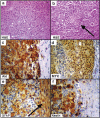Overexpression of c-MYC promotes an undifferentiated phenotype in cultured astrocytes and allows elevated Ras and Akt signaling to induce gliomas from GFAP-expressing cells in mice
- PMID: 17047730
- PMCID: PMC1615889
- DOI: 10.1017/s1740925x04000249
Overexpression of c-MYC promotes an undifferentiated phenotype in cultured astrocytes and allows elevated Ras and Akt signaling to induce gliomas from GFAP-expressing cells in mice
Abstract
The c-MYC protooncogene is overexpressed in the most malignant primary brain tumor, glioblastoma multiforme (GBM), and has been correlated with the undifferentiated character of several cell types. However, the role of Myc activity in the generation of GBMs is not known. In this report, we show that gene transfer of c-MYC to GFAP-expressing astrocytes in vitro promotes the outgrowth of GFAP-negative, nestin-expressing cells with progenitor-like morphology, growth characteristics and gene-expression pattern. In addition, gene transfer of c-MYC to GFAP-expressing astrocytes in vivo induces GBMs when co-expressed with activated Ras and Akt. Without c-MYC, Ras+Akt induces GBMs from nestin-expressing CNS progenitors but is insufficient in GFAP-expressing differentiated astrocytes. The ability of Myc activity to enhance the oncogenic effects of Ras+Akt appears to be limited to GFAP-expressing astrocytes because nestin-expressing progenitors show no increase in GBM formation with the addition of MYC to Ras+Akt. These studies indicate that one role of MYC activity in the formation of gliomas might be to either promote or reinforce an undifferentiated phenotype required for glioma cells to respond to the oncogenic effects of elevated Ras and Akt activity.
Figures




References
-
- Bigner DD, McLendon RE, Bruner JM, Russell DS, Rubinstein LJ. Russell and Rubinstein's Pathology of Tumors of the Nervous System. Hodder Arnold; 1998.
-
- Engelhard HH, 3rd, Butler A.B.t., Bauer KD. Quantification of the c-myc oncoprotein in human glioblastoma cells and tumor tissue. Journal of Neurosurgery. 1989;71:224–232. - PubMed
Grants and funding
LinkOut - more resources
Full Text Sources
Molecular Biology Databases
Miscellaneous

